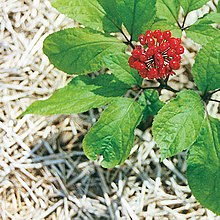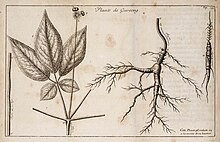| Panax ginseng | |
|---|---|

| |
| Scientific classification | |
| Kingdom: | Plantae |
| Clade: | Tracheophytes |
| Clade: | Angiosperms |
| Clade: | Eudicots |
| Clade: | Asterids |
| Order: | Apiales |
| Family: | Araliaceae |
| Genus: | Panax |
| Species: | P. ginseng |
| Binomial name | |
| Panax ginseng C.A.Mey. | |
| Synonyms | |
Panax ginseng, ginseng, also known as Asian ginseng, Chinese ginseng or Korean ginseng, is a species of plant whose root is the original source of ginseng. It is a perennial plant that grows in the mountains of East Asia.
Panax ginseng is primarily cultivated in Korea. While all South Korean ginseng is Panax ginseng, ginseng production in China encompasses both Panax ginseng and South China ginseng (Panax notoginseng).
Names
Panax ginseng is called Rénshēn (人蔘 or 人参 or 人參; lit. 'ginseng') in Mandarin (Chinese), Insam (Korean: 인삼; Hanja: 人蔘) in Korean, Nhân Sâm in Vietnamese and Ninjin (人参) in Japanese. The specific epithet ginseng means "man-herb" or "forked root".
Description
Panax ginseng is a herbaceous perennial growing from 30 to 60 cm tall. Plants have a spindle- or cylinder-shaped taproot, usually with 1 or 2 main branches. Plants produce 3 to 6 leaves that are palmately compound, with each leaf having 3 to 5 leaflets. The margins of the leaflets are densely serrated. The flowers are born in a solitary inflorescence that is a terminal umbel with 30 to 50 flowers. The peduncles of the flowers are 15 to 30 cm long. The flower ovary is 2-carpellate, with each carpel having two distinct styles. Mature fruits are 4–5 x 6–7 millimeters in size, red in color, and round with flattened ends. The white seeds are kidney-shaped. The (2n) diploid chromosome count is 48.
Taxonomy

In a letter dated 12 April 1711, the French Jesuit mathematician and cartographer Pierre Jartoux described gin-seng, a Chinese name for a plant now known as Panax ginseng. According to Jartoux, the name means "form of man", which refers to the shape of the root.
Distribution
Panax ginseng is native to mountainous regions of the Russian Far East, Northeast China, and the Korean Peninsula. It is a protected plant in Russia and China, and most commercial ginseng is now sourced from plants cultivated in China, Korea and Russia. It is also cultivated in some areas of Japan. The plant is a slow-growing perennial, and the roots are usually harvested when the plants are five or six years old.
Cultivation
Panax ginseng is one of the most commonly cultivated ginseng species, along with P. notoginseng (found naturally in China) and P. quinquefolius.
Research
There is no high-quality evidence for ginseng having any health effect. Ginseng phytochemicals, such as ginsenosides, are under preliminary research for their potential to affect fatigue in people with multiple sclerosis, as well as various cognitive effects and aging-related disorders. Panax ginseng is generally considered safe for adults when used for less than six months, but may be unsafe to use for longer than six months.
Potential for adverse effects
Use of Panax ginseng during pregnancy and breastfeeding is potentially unsafe. It may have adverse effects in people with immune disorders, bleeding conditions, cardiovascular diseases or cancer. It should not be used by children.
Folk medicine
Ginseng is used as an herb in folk medicine. It is consumed due to the belief that it may improve memory and cognition in otherwise healthy adults and that it may improve sexual function in adults with erectile dysfunction.
See also
References
- Synonyms in Catalogue of life
- ^ "Panax ginseng". Germplasm Resources Information Network. Agricultural Research Service, United States Department of Agriculture. Retrieved 13 February 2018.
- ^ "Asian Ginseng". National Center for Complementary and Integrative Health (NCCIH). September 2016. Retrieved June 24, 2017.
- English Names for Korean Native Plants (PDF). Pocheon: Korea National Arboretum. 2015. p. 559. ISBN 978-89-97450-98-5. Archived from the original (PDF) on 25 May 2017. Retrieved 24 December 2016 – via Korea Forest Service.
- ^ Experts, EduGorilla Prep. UPSC Drug Inspector Book 2024 (Paper I and Paper II) - 20 Practice Tests (1500 Solved Questions). EduGorilla Community Pvt. Ltd. p. 92. ISBN 978-93-5556-321-7.
- Perkins, Dorothy (2013-11-19). Encyclopedia of China: History and Culture. Routledge. p. 181. ISBN 978-1-135-93562-7.
- Braun, Lesley; Cohen, Marc (2010-06-24). Herbs and Natural Supplements Inkling: An Evidence-Based Guide. Elsevier Health Sciences. p. 509. ISBN 978-0-7295-7910-0.
- Experts, EduGorilla Prep. GPAT 2024 - Graduate Pharmacy Aptitude Test - 10 Full Length Mock Tests and 15 Sectional Tests (1600 Solved Questions). EduGorilla Community Pvt. Ltd. p. 72. ISBN 978-93-5556-293-7.
- Trotha, Alexandra-Friederike von; Schmitz, Oliver Johannes (2019-12-11). Qualitätskontrolle in der TCM: Chinesische Heilpflanzen auf dem Prüfstand (in German). Springer-Verlag. p. 91. ISBN 978-3-662-59256-4.
- Gledhill (2008), p. 178.
- Xiang, Qibai; Lowry, Porter P. "Panax quinquefolius". Flora of China. Vol. 13. Retrieved 5 January 2024 – via eFloras.org, Missouri Botanical Garden, St. Louis, MO & Harvard University Herbaria, Cambridge, MA.
- Jartoux (1713), pp. 242–246.
- Brinckmann & Huang (2018), pp. 908–910.
- Jartoux (1713), p. 245.
- Mahady, Gail B.; Fong, Harry H.S.; Farnsworth, N.R. (2001). Botanical Dietary Supplements. CRC Press. pp. 207–215. ISBN 978-90-265-1855-3.
- Baeg, In-Ho; So, Seung-Ho (2013). "The world ginseng market and the ginseng". Journal of Ginseng Research. 37 (1): 1–7. doi:10.5142/jgr.2013.37.1. PMC 3659626. PMID 23717152. Retrieved 11 August 2018.
- ^ "Panax ginseng". MedlinePlus, US National Library of Medicine. 9 October 2023. Retrieved 24 March 2024.
- de Oliveira Zanuso, Bárbara; de Oliveira dos Santos, Ana Rita; Miola, Vitor Fernando Bordin; Guissoni Campos, Leila M.; Spilla, Caio Sergio Galina; Barbalho, Sandra Maria; et al. (2022-05-01). "Panax ginseng and aging related disorders: A systematic review". Experimental Gerontology. 161: 111731. doi:10.1016/j.exger.2022.111731. ISSN 0531-5565.
Bibliography
- Brinckmann, Josef; Huang, Linfang (2018-11-01). "American Ginseng a Genuine Traditional Chinese Medicine". Medicina Nei Secoli: Journal of History of Medicine and Medical Humanities. 30 (3): 907–928. ISSN 0394-9001. Retrieved 4 January 2024.
- Gledhill, David (2008). The Names of Plants (4th ed.). Cambridge University Press. ISBN 978-0-521-86645-3.
- Jartoux, Pierre (1713). "XXV. The description of a tartarian plant, call'd gin-seng; with an account of its virtues. In a letter from Father Jartoux, to the Procurator General of the Missions of India and China. Taken from the tenth volume of letters of the Missionary Jesuits, printed in Paris in octavo, 1713". Philosophical Transactions of the Royal Society of London. 28 (337): 237–247. doi:10.1098/rstl.1713.0025.